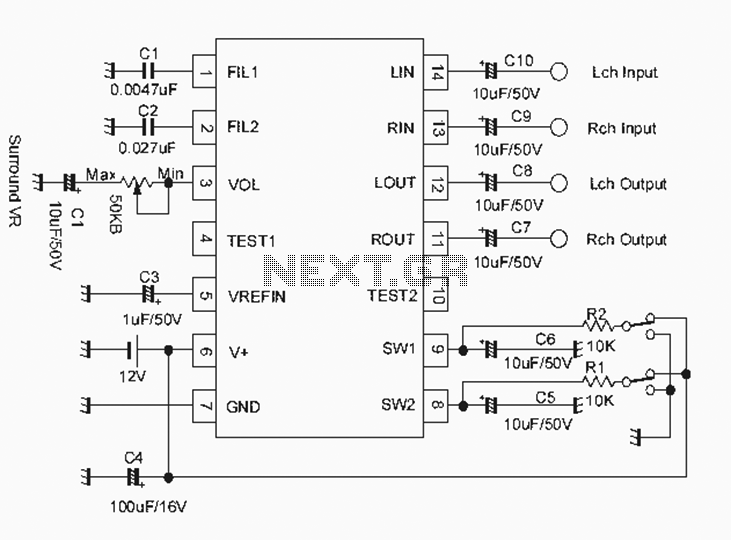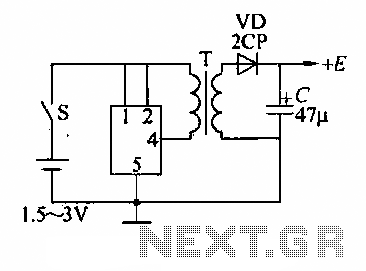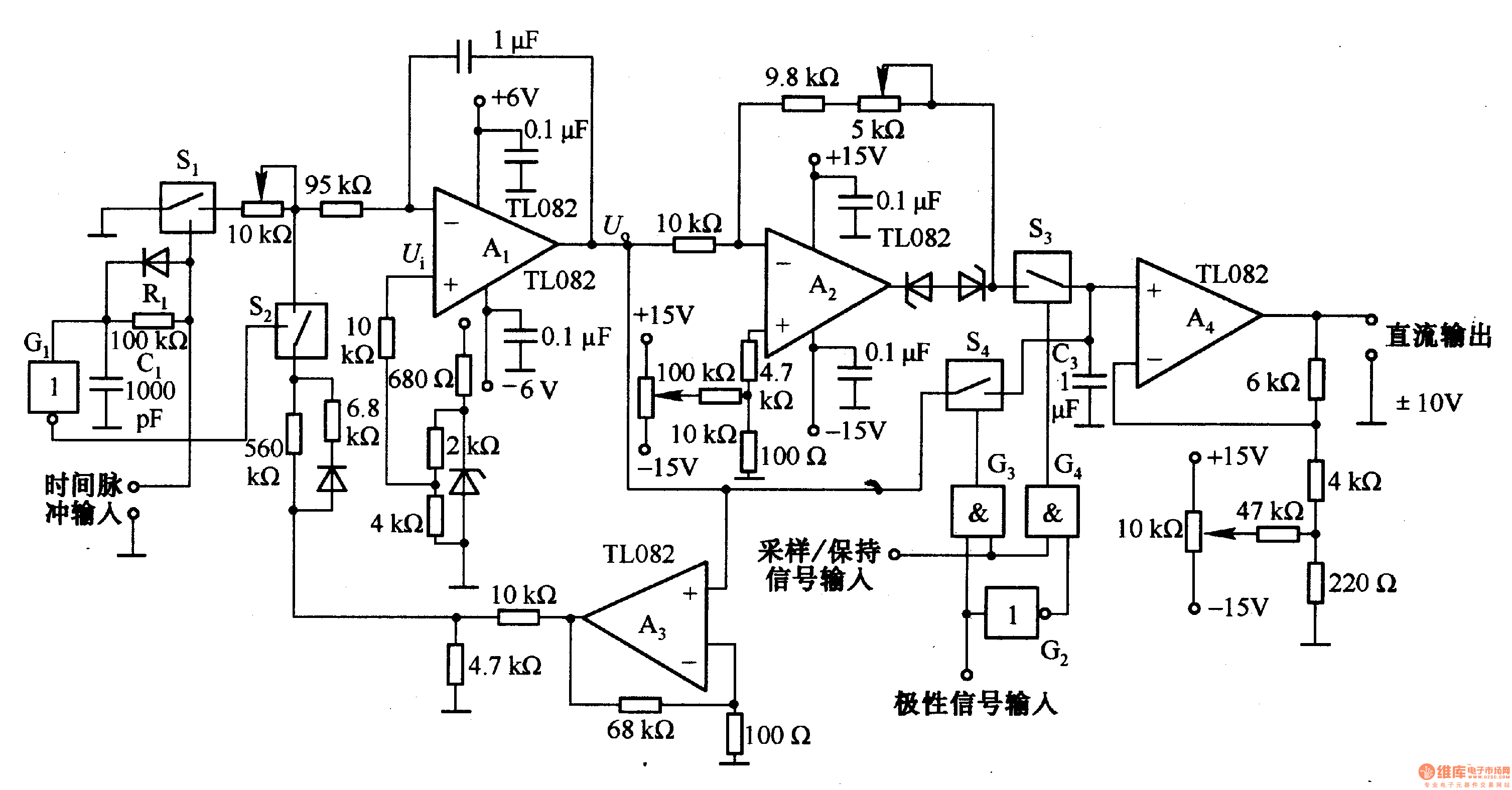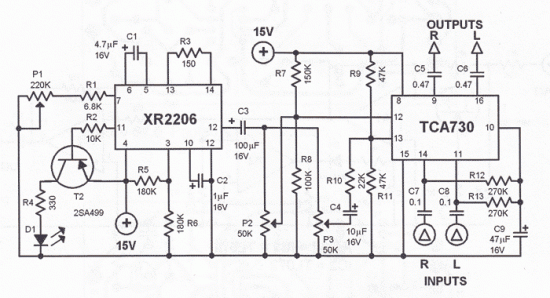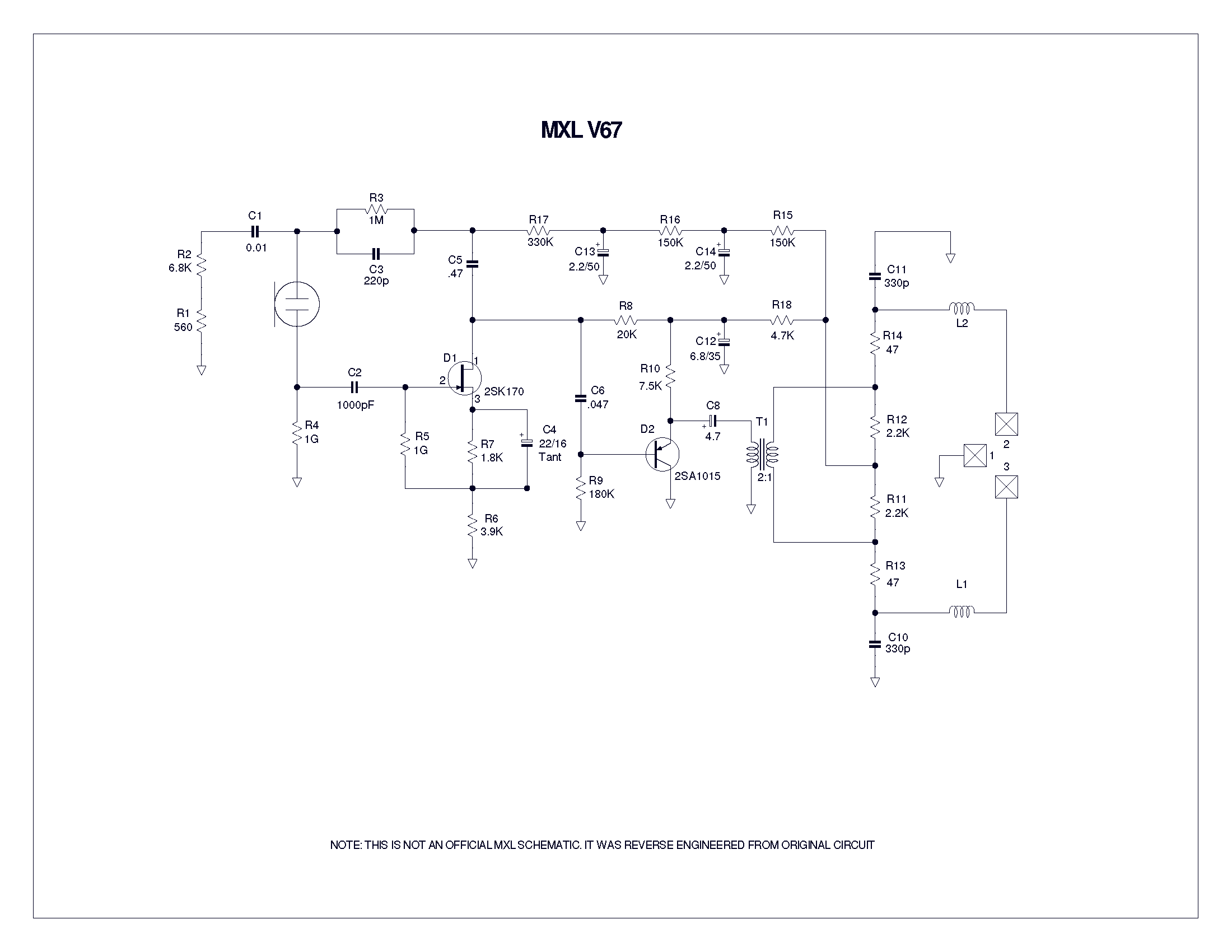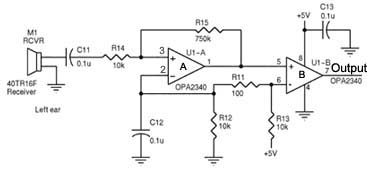
Broskie auto-bias circuit
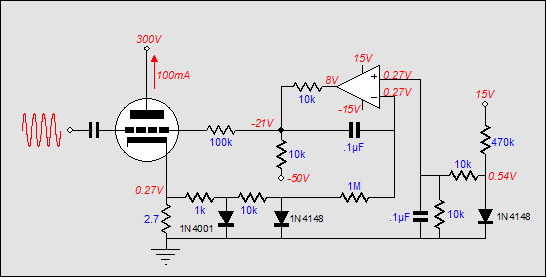
It is embarrassing to acknowledge that the blog post from April 29 contained several schematic errors of my own making, particularly in the variation of Morgan Jones's circuit. One of the resistor values was incorrect by a factor of ten, and more critically, one of the OpAmp inputs was reversed. Below is the corrected schematic. The generic DC servo circuit functions correctly as long as the amplifier does not amplify asymmetrical signals and the output stage's current swings remain within the class-A operational window. However, if the output stage transitions from class-A to class-AB operation, the DC servo will detect a net DC increase at its inverting input. It will attempt to realign the amplifier with its reference voltage, but concurrently, the capacitor will begin to charge to a higher voltage. This will negatively affect the bias voltage until the input signal diminishes sufficiently for it to discharge back to its idle value. The graph illustrates the tube's current conduction in hot pink, the grid bias voltage in blue, and the capacitor's voltage differential in green. A signal burst excessively charges the DC servo's capacitor, causing its output voltage to deviate by over half a volt (602 mV). The principle underlying clipping-style auto-bias circuits is straightforward: monitor the tube's current conduction while operating in class-A and disregard its AC conduction beyond class-A when the tube transitions to class-B. The clipping diode shorts to ground any error signals exceeding its forward voltage. The forward voltage of the clipping diode establishes a window that extends from 0V to the cathode-to-anode voltage needed to activate the diode. By setting the DC servo's reference voltage to half the diode's forward voltage, the current window encompasses the full extent of class-A operation, preventing one tube from cutting off while the other conducts beyond the top edge of the window. This configuration works perfectly with no input signal, adequately with large input signals that delve into class-B, but less effectively with input signals just exceeding class-A operation of the output tubes. An alternative approach involves not clipping the error signal but using it to prevent excessive charging of the DC servo's capacitor, which could disrupt the bias voltage. This concept is the foundation of the Broskie auto-bias circuit. The triode's idle current must be sufficient to generate the same voltage across the cathode resistor as the diode's forward voltage, which serves as the servo's reference voltage. If the diode connected to the tube's cathode is effectively removed from the circuit at idle, the OpAmp compares the cathode voltage to its reference voltage and maintains the necessary grid-bias voltage to achieve this idle current. As long as the tube operates within twice the diode's forward voltage (Vd) at its cathode, it will function in pure class-A, and the DC servo will manage the bias voltage effectively. However, once the tube exits class-A, the cathode voltage will exceed twice Vd, causing the diode connected to the cathode to conduct and charge capacitor C2. Given that capacitors C1 and C2, as well as resistors R1 and R2, are equal in value, the charging rate will be identical for both capacitors. Consequently, the DC servo's reference voltage will be affected in a corresponding manner as the servo's capacitor is also affected. This situation is analogous to docking a boat to a floating dock: regardless of the tide's rise or fall, the boat will maintain its relative position to the dock. The schematic provided illustrates all components involved in this arrangement.
The schematic includes the following key components:
1. **OpAmp**: This operational amplifier is central to the feedback mechanism, comparing the cathode voltage to the reference voltage and adjusting the grid-bias voltage accordingly.
2. **Resistors (R1, R2)**: These resistors are equal in value and help set the reference voltage for the DC servo circuit.
3. **Capacitors (C1, C2)**: These capacitors are also equal in value and play crucial roles in charging and discharging to maintain the bias voltage.
4. **Clipping Diode**: This diode is essential for preventing excessive error signals from affecting the operation of the circuit, ensuring that the bias voltage remains stable within the desired operational window.
The circuit's design allows for effective bias management, ensuring that the amplifier operates optimally across its intended range while minimizing distortion and maintaining fidelity. The careful selection of component values and the configuration of the feedback loop are critical for achieving the desired performance characteristics.Considering that I had complained of a schematic typo from Siliconix, it is doubly embarrassing that that April 29`s blog held a few schematic typos of my own creation: in the variation on Morgan Jones`s circuit one of the resistor`s values was off by a decade and, more damning, one of the OpAmp`s inputs was reversed. Below, the corrected schemati c is displayed. (The 4/29 blog has been updated to reflect these corrections. ) The generic DC servo circuit (shown below) works perfectly as long as the amplifier does not amplify asymmetrical signals and as long as the output stage`s current swings are within in the class-A window of operation. However, once the output stage jumps out of class-A into class-AB operation, the DC servo will see a net DC increase at its inverting input and it will strive to bring the amplifier back into line with its reference voltage, but at the same time the capacitor will begin to charge to higher voltage, which will throw the bias voltage off (negatively) until the input signal subsides enough to let it discharge back to its idle value, as shown in the graph below.
The graph above shows the tube`s current conduction in hot pink, the grid bias voltage in blue, and the capacitor`s voltage differential in green. The signal burst excessively charges the DC servo`s capacitor and its output voltage is thrown off the mark by over half a volt (602mV).
The principle behind the clipping-style auto-bias circuits is also simple: monitor the tube`s current conduction while it is operating in class-A; ignore its AC conduction beyond class-A, when the tube moves into class-B. The clipping diode shorts to ground error signals greater than its forward voltage. In other words, the clipping diode`s forwards voltage creates a window that extends from 0V to the cathode-to-anode voltage required to turn the diode on (silicon diodes also have cathodes).
By setting the DC servo`s reference voltage to half of the diode`s forwards voltage, we ensure that the window of current encompasses the extent of class-A operation that the tube(s) can undergo, without one tube cutting off, while the other conducts beyond the window`s top edge. This plan works perfectly with no input signal; well with large input signals that extend deep into class-B; not so well with input signal just beyond class-A operation of the output tubes.
What if we don`t clip the error signal What if, instead, we use it to prevent the DC servo`s capacitor`s excessive charging from throwing the bias voltage off Well, that`s the idea behind the Broskie auto-bias circuit. How does it work The triode`s idle current must be great enough to establish the same voltage across the cathode resistor as the diode`s forward voltage, as this voltage is used as the servo`s reference voltage.
(Imagine that the diode that attaches to the tube`s cathode has been removed from the circuit, which it effectively is at idle). The OpAmp compares the cathode voltage to its reference voltage and then establishes and maintains grid-bias voltage required to meet this compulsory idle current.
Now, as long as the tube runs within the boundary of twice the diode`s forward voltage (Vd) at its cathode, the triode will operate in pure class-A and the DC servo will handle setting the bias voltage quite nicely. Once the tube leaves the confines of class-A, however, its cathode voltage will exceed twice Vd and the diode attached to the cathode will begin to conduct, charging C2 as a result.
Since capacitors C1 and C2 are equal in value, as are resistors R1 and R2, the rate of charging will be the same between both capacitors. In other words, the DC servo`s reference voltage will be thrown off in a matching way as the servo`s own capacitor is thrown off.
It`s much like docking a boat to a floating dock: no matter how much the tide rises or falls, the boat will remain in the same relation to the dock. In the schematic above, we see all 🔗 External reference
The schematic includes the following key components:
1. **OpAmp**: This operational amplifier is central to the feedback mechanism, comparing the cathode voltage to the reference voltage and adjusting the grid-bias voltage accordingly.
2. **Resistors (R1, R2)**: These resistors are equal in value and help set the reference voltage for the DC servo circuit.
3. **Capacitors (C1, C2)**: These capacitors are also equal in value and play crucial roles in charging and discharging to maintain the bias voltage.
4. **Clipping Diode**: This diode is essential for preventing excessive error signals from affecting the operation of the circuit, ensuring that the bias voltage remains stable within the desired operational window.
The circuit's design allows for effective bias management, ensuring that the amplifier operates optimally across its intended range while minimizing distortion and maintaining fidelity. The careful selection of component values and the configuration of the feedback loop are critical for achieving the desired performance characteristics.Considering that I had complained of a schematic typo from Siliconix, it is doubly embarrassing that that April 29`s blog held a few schematic typos of my own creation: in the variation on Morgan Jones`s circuit one of the resistor`s values was off by a decade and, more damning, one of the OpAmp`s inputs was reversed. Below, the corrected schemati c is displayed. (The 4/29 blog has been updated to reflect these corrections. ) The generic DC servo circuit (shown below) works perfectly as long as the amplifier does not amplify asymmetrical signals and as long as the output stage`s current swings are within in the class-A window of operation. However, once the output stage jumps out of class-A into class-AB operation, the DC servo will see a net DC increase at its inverting input and it will strive to bring the amplifier back into line with its reference voltage, but at the same time the capacitor will begin to charge to higher voltage, which will throw the bias voltage off (negatively) until the input signal subsides enough to let it discharge back to its idle value, as shown in the graph below.
The graph above shows the tube`s current conduction in hot pink, the grid bias voltage in blue, and the capacitor`s voltage differential in green. The signal burst excessively charges the DC servo`s capacitor and its output voltage is thrown off the mark by over half a volt (602mV).
The principle behind the clipping-style auto-bias circuits is also simple: monitor the tube`s current conduction while it is operating in class-A; ignore its AC conduction beyond class-A, when the tube moves into class-B. The clipping diode shorts to ground error signals greater than its forward voltage. In other words, the clipping diode`s forwards voltage creates a window that extends from 0V to the cathode-to-anode voltage required to turn the diode on (silicon diodes also have cathodes).
By setting the DC servo`s reference voltage to half of the diode`s forwards voltage, we ensure that the window of current encompasses the extent of class-A operation that the tube(s) can undergo, without one tube cutting off, while the other conducts beyond the window`s top edge. This plan works perfectly with no input signal; well with large input signals that extend deep into class-B; not so well with input signal just beyond class-A operation of the output tubes.
What if we don`t clip the error signal What if, instead, we use it to prevent the DC servo`s capacitor`s excessive charging from throwing the bias voltage off Well, that`s the idea behind the Broskie auto-bias circuit. How does it work The triode`s idle current must be great enough to establish the same voltage across the cathode resistor as the diode`s forward voltage, as this voltage is used as the servo`s reference voltage.
(Imagine that the diode that attaches to the tube`s cathode has been removed from the circuit, which it effectively is at idle). The OpAmp compares the cathode voltage to its reference voltage and then establishes and maintains grid-bias voltage required to meet this compulsory idle current.
Now, as long as the tube runs within the boundary of twice the diode`s forward voltage (Vd) at its cathode, the triode will operate in pure class-A and the DC servo will handle setting the bias voltage quite nicely. Once the tube leaves the confines of class-A, however, its cathode voltage will exceed twice Vd and the diode attached to the cathode will begin to conduct, charging C2 as a result.
Since capacitors C1 and C2 are equal in value, as are resistors R1 and R2, the rate of charging will be the same between both capacitors. In other words, the DC servo`s reference voltage will be thrown off in a matching way as the servo`s own capacitor is thrown off.
It`s much like docking a boat to a floating dock: no matter how much the tide rises or falls, the boat will remain in the same relation to the dock. In the schematic above, we see all 🔗 External reference
Warning: include(partials/cookie-banner.php): Failed to open stream: Permission denied in /var/www/html/nextgr/view-circuit.php on line 713
Warning: include(): Failed opening 'partials/cookie-banner.php' for inclusion (include_path='.:/usr/share/php') in /var/www/html/nextgr/view-circuit.php on line 713
